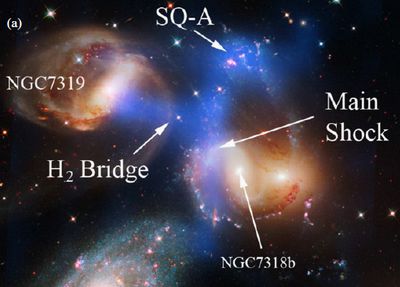Prof. Gao, Yu in PMO and his cooperator have performed the first Herschel observations of the giant intergalactic filament away from the major star forming regions in Stephan’s Quintet with the [OI] 63 μm and [C II] 158 μm fine-structure transitions, and a single para-H2O. The filament is believed to form when a high-speed intruder to the group collided with a clumpy intergroup gas (see figure).

(By with GAO Yu)
Based on a model of the heating and cooling of the [C II]- and [O I]-emitting gas, Appleton et al. ‘s measurements suggest that the emission arises from a warm diffuse medium. They found that the strong enhancement of [C II] in the filament, relative to PAH and dust continuum, suggests that the [C II] is heated by shocks and turbulence, but not star formation. The possibility that [C II] can be excited at a large scale by the dissipation of mechanical energy (turbulence and shocks) provides a potential new source of [C II] emission when interpreting [C II] in high-redshift galaxies. These new results have been published in 2013, The Astrophysical Journal Vol. 777, Page 66.
